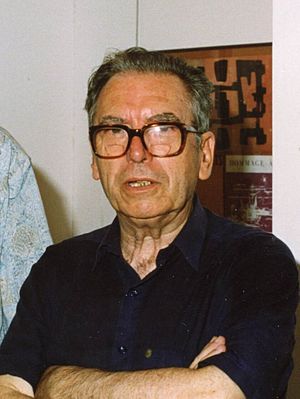Joan-Josep Tharrats facts for kids
Quick facts for kids
Joan-Josep Tharrats
|
|
|---|---|
 |
|
| Born | 1918 |
| Died | 2001 (aged 82–83) |
| Nationality | Spanish |
| Occupation | Painter, publisher |
| Known for | Dau al set |
Joan-Josep Tharrats i Vidal (born in Girona, Spain, in 1918 – died in Barcelona, Spain, in 2001) was a famous Spanish painter. He was also an art thinker and helped publish books and magazines.
Joan-Josep came from a family involved in industry. His father, Josep Tharrats i Vilà, was a businessman and a poet. From 1932 to 1935, Joan-Josep lived in Béziers, France. After that, he moved to Barcelona and started studying art at the Escola Massana.
Contents
Early Life and Art Style
Joan-Josep Tharrats' art studies were stopped by the Spanish Civil War. He couldn't go back to art until 1942.
At first, his paintings looked a bit like Impressionism. This style uses small, thin brushstrokes to show how light changes. But soon, he became interested in abstract art. This is art that doesn't try to show things exactly as they look. Instead, it uses shapes, colors, and lines.
He was very inspired by artists like Piet Mondrian and Wassily Kandinsky. These artists were pioneers of abstract art. From 1946, Tharrats also started using collage in his work. Collage is an art technique where you glue different materials onto a surface.
Founding Dau al Set
In 1947, Joan-Josep met many other artists in Barcelona. These included Arnau Puig Grau, Joan Ponç, Modest Cuixart, Antoni Tàpies, Joan Brossa, and Josep Vicenç Foix.
With some of these artists, he started an important art group called Dau al Set. This group also published a magazine with the same name. They printed the magazine right in Tharrats' own art studio.
Evolving Art and International Fame
Joan-Josep Tharrats was one of the most important artists in Spain after the war. He was part of the "avant-garde" movement. This means he was creating new and experimental art.
His style changed over time. When he was with Dau al Set, his abstract art had influences from surrealism. Surrealism is an art movement that explores dreams and the unconscious mind. Later, his art moved towards a style called Art Informel. This style focuses on textures, colors, and lines that are more free and spontaneous.
Tharrats didn't just paint. He also created many other types of art:
- Posters
- Illustrations for books
- Large wall paintings (murals)
- Stained glass windows
- Mosaics
- Jewelry
- Designs for opera stages (scenography)
Exhibitions and Recognition
In 1949, Joan-Josep Tharrats had his first solo art show in Barcelona. It was at the El Jardín gallery. He quickly became one of the most important Catalan artists known around the world.
From 1954, his work was often shown at the Sala Gaspar in Barcelona. From 1955, his art was also displayed in Stockholm, Sweden, and New York City, USA.
His art was shown at major international art events:
- The 5th São Paulo Biennale in 1959
- The Venice Biennale in 1960 and 1964
In 1966, he helped start the Associació d'Artistes Actuals. This group supported modern artists.
Later Years
In 2000, Joan-Josep Tharrats worked on his last art show. He created both large and small oil paintings for this exhibition. It was organized by the Galeria Taüll in Barcelona.
After he passed away, a special traveling exhibition of his work was created in 2009. It was called "Les maculatures de Tharrats." This show was put together by the Cultural Department of the Diputació de Barcelona.
See also
 In Spanish: Joan-Josep Tharrats para niños
In Spanish: Joan-Josep Tharrats para niños

